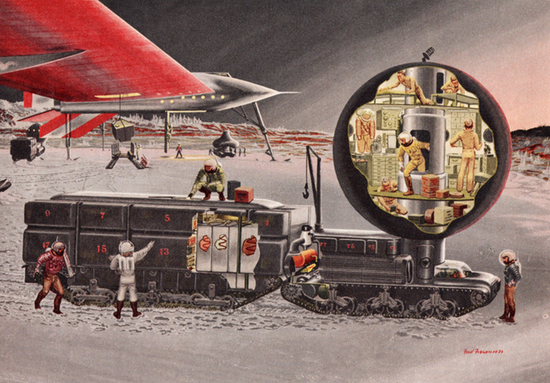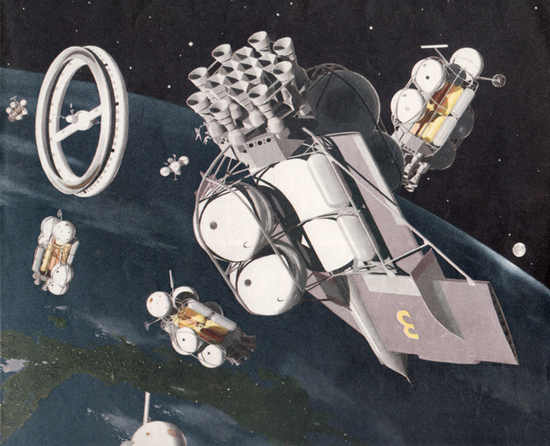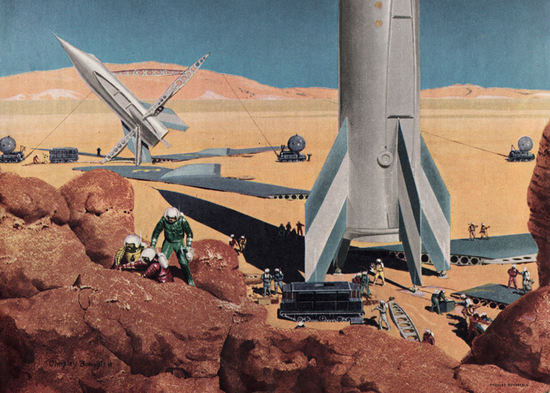Wernher von Braun’s Martian Chronicles
In 1954, a special issue of Collier’s magazine envisioned a ten-ship flotilla to the red planet.
/https://tf-cmsv2-smithsonianmag-media.s3.amazonaws.com/filer/201207300330341954-april-30-colliers-cover-470x251.jpg)
![]()

Astronauts plan for a trip to the Martian equator over snowy terrain (1954)
Assuming everything goes according to plan, NASA’s Curiosity rover will touch down on the surface of Mars this Sunday, August 5th at 10:31 PDT. Curiosity travels in the cosmic wake of not only the pioneering landers and rovers that have made journeys to Mars before, but also the innumerable visionaries who showed us how we might get there —well before it was possible.
From 1952 until 1954, the weekly magazine Collier’s published a series of articles on space exploration spread out across eight issues. Several of the articles were written by Wernher von Braun, the former Third Reich rocket scientist who began working for the U.S. after WWII. The Collier’s series is said to have inspired countless popular visions of space travel. This impact was in no small part due to the gorgeous, colorful illustrations done by Chesley Bonestell, Fred Freeman and Rolf Klep.
The last of the Collier’s space-themed series was the April 30, 1954, issue that featured a cover showing the planet Mars and two headlines: “Can We Get to Mars?” and directly underneath: “Is There Life on Mars?” The article, “Can We Get to Mars?,” by von Braun is a fascinating read that looks at everything from the impact of meteors on spacecraft to the stresses of living in cramped quarters during such a long journey. Even when astronauts finally arrived on Mars, they’d still be subjected to claustrophobic living conditions, as you can see from the illustration above by Fred Freeman. The astronauts—who in this illustration have landed on an icy Martian pole—live in inflatable, pressurized spheres that are mounted on tractors.
Von Braun’s story in the 1954 issue explained that he didn’t believe he’d see a man on Mars within his lifetime. In fact, von Braun believed that it would likely be 100 years before a human foot would touch Martian soil. But there was absolutely no doubt that we would get there.
Will man ever go to Mars? I am sure he will—but it will be a century or more before he’s ready. In that time scientists and engineers will learn more about the physical and mental rigors of interplanetary flight—and about the unknown dangers of life on another planet. Some of that information may become available within the next 25 years or so, through the erection of a space station above the earth (where telescope viewings will not be blurred by the earth’s atmosphere) and through the subsequent exploration of the moon, as described in previous issues of Collier’s.
But unlike NASA’s current Mars mission, von Braun’s vision for travel included humans rather than simply rovers. As Erik Conway, historian at the Jet Propulsion Laboratory explains, “There have also always been—since at least Wernher von Braun—people proposing expeditions to Mars with humans, with astronauts. Von Braun’s idea was to send a flotilla of spacecraft, not just one. As you’ve seen in the Collier’s magazines and so on, he was a big promoter of that. And that affected how the American public saw Mars as well. So it was being promoted as a future abode of life for us humans—and it still is in a lot of the enthusiast literature. That hasn’t changed. It’s just the funding isn’t there to actually accomplish it.”
The funding may not be there today, but the space interest revival we’re currently seeing under the unofficial leadership of astrophysicist and media personality Neil deGrasse Tyson could very well help change that. Look for a reboot of the late Carl Sagan’s 1980 mini-series Cosmos in 2013, starring Tyson.
For now, we’ll just have to settle for the exciting discoveries that (hopefully) will be beaming down from Mars next week and some good old fashioned space art. Below are samples of the amazing illustrations from the April 30, 1954 issue of Collier’s by Bonestell, Freeman and Klep.

Workers assembling 10 rocket ships for a mission to Mars
Wernher von Braun imagined that spacecraft would be assembled 1,000 miles from earth near a wheel-shaped space station.

Spacecraft being assembled near the wheel-shaped space station, as envisioned by Wernher von Braun

The cropped illustration above, by Chesley Bonestell shows four of the ten spacecraft von Braun imagined would undertake the journey.
The first landing party takes off for Mars. Two other landing planes will wait until runway is prepared for them, and the remaining seven ships will stay in 600-mile orbit. Arms on cargo ships hold screenlike dish antenna (for communication), trough-shaped solar mirrors (for power).

Charting a course to Mars in a 1954 issue of Collier’s
The illustration above by Rolf Klep explains how the earth and Mars must be positioned in order for a successful flight to occur.

This illustration above of astronauts preparing for their return flight was done by Chesley Bonestell.
After 15 month exploration, the Mars expedition prepares for return flight to earth. Two landing planes are set on tails, with wings and landing gear removed. They will rocket back to the 600-mile orbit on first leg of journey

This illustration, by Fred Freeman shows all ten spacecraft as they travel to Mars.
Illustration shows how the landing planes are assembled in 600-mile Martian orbit. Pointed noses are removed from three of 10 ships that made trip from earth; wings and landing gear are fitted to them. Cutaway of plane in the foreground shows personnel, tractors in ship
/https://tf-cmsv2-smithsonianmag-media.s3.amazonaws.com/accounts/headshot/matt-novak-240.jpg)
/https://tf-cmsv2-smithsonianmag-media.s3.amazonaws.com/accounts/headshot/matt-novak-240.jpg)